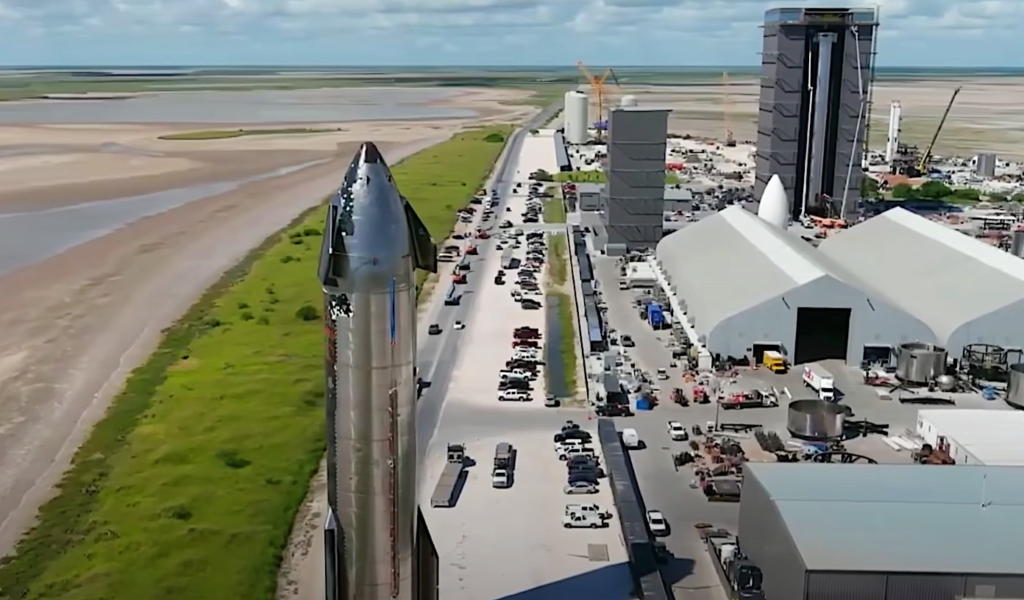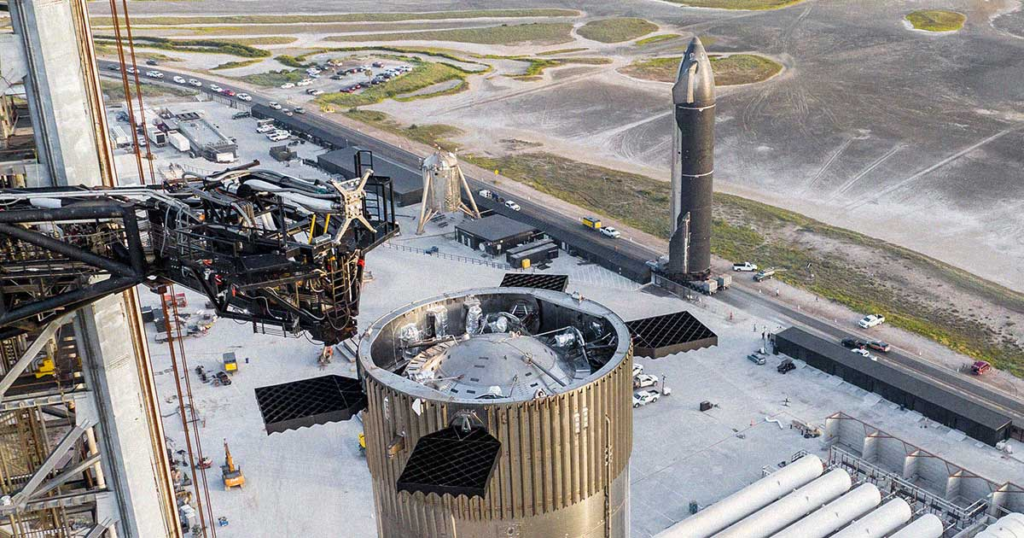
When Can We Realistically Expect Starship’s Second Test Flight?
At this point, SpaceX is officially ready to launch Ship 25 and Booster 9 which are stacked and just completed some final testing. The only thing holding the launch back is approval from the FAA, which has been in the works for a while now. Even though no official launch date has been shared, based on recent updates and patterns prior to the first integrated test flight back in April, we can estimate when this rocket will lift off.
Current signs suggest a launch next month in mid to late November is very likely. A full flight-like wet dress rehearsal has been completed along with successful pad testing after a long list of upgrades were made. The final physical step will be arming the test article’s flight termination system which is done right before launch.
We know from the first fight test that SpaceX will launch very soon after getting approval, as in only a few days if not less. We also know the FAA is nearing certain deadlines related to approval timing and reviews. Here I will go more in-depth into a possible launch date, what still needs to be completed, what to expect in the next few weeks, and more.
Launch Date

Right now, most people believe that next month Starship’s second integrated test flight will take place. Recent updates from the company in addition to other sources support this estimate. Two days ago on the 24th for example, SpaceX loaded Starship and Super Heavy with more than 10 million pounds of propellant in a flight-like rehearsal ahead of launch. The test went well and soon after the company tweeted saying, “Vehicle is ready for the second test flight of a fully integrated Starship, pending regulatory approval.”
In other words, they are ready to launch as soon as they get approval. This matches up well with the last test back in April. Specifically, on April 14th, the Federal Aviation Administration issued a launch license to SpaceX for the first integrated test flight of the Starship/Super Heavy launch vehicle. When SpaceX received this approval, they scheduled the flight to take place only 3 days later, no earlier than April 17th. On the 17th, SpaceX planned to launch and tried but scrubbed the first attempt. They then managed to launch a few days later on the 20th, less than a week after receiving approval.
We can expect a very similar process here where approval is announced either by SpaceX or the FAA and that will determine the launch date, a few days later. On the last flight, the launch window opened at 8 a.m. Eastern April 17 and ran through 10:30 a.m. Eastern, with backup opportunities from April 18 through the 22nd. When the approval came in the FAA said, “After a comprehensive license evaluation process, the FAA determined SpaceX met all safety, environmental, policy, payload, airspace integration and financial responsibility requirements.”
One of the main differences this time around is right now, we are waiting on the Fish and Wildlife Service. A few months ago in August, the FAA sent a letter and draft assessment to the U.S. Fish and Wildlife Service requesting re-initiation of the Endangered Species Act consultation. The first launch of Starship ended up destroying the pad and sending various debris in every direction. The main change addressing this specific problem is the addition of the water-cooled steel plate. The FAA passed it off to the U.S. Fish and Wildlife Service to determine if that change will prevent what happened on the last attempt and ensure the wildlife and environment are safe. They specifically gave the agency a 135-day timeline to complete this process. The 135-day timeline began at the very beginning of August which would place its end date around December 15th at the latest.
However, by now they should be nearing completion and approve the changes within a few weeks. There also has been some more pressure put on the FAA as certain SpaceX officials claim the agency is holding them back. All of which could impact the time to get approved for this second test flight. Before the first flight, the FAA commented, “The FAA is responsible for protecting the public during commercial space transportation launch and reentry operations. We carefully analyzed the public safety risks during every stage of the mission and required SpaceX to mitigate those risks” they said. They are taking a similar approach for the second launch but with some extra caution based on how the first flight went.
Second Flight Test

The flight profile is very similar to the first launch with just a few alterations. Assuming SpaceX does get approval next month, it will go from 0 to 100 in the sense that the company is waiting patiently to get this rocket off the ground.
On the day of launch, main operations will begin two hours before liftoff with the SpaceX Flight Director conducting a poll and verifying go for propellant load. Just 21 minutes later, Booster LOX (liquid oxygen) will begin loading into the first stage. At the same time, the Booster Fuel load (liquid methane) will also start flowing to the booster. 1 hour and 22 minutes prior to launch and SpaceX will begin loading liquid methane into the upper stage. 5 minutes later and this process will begin with the liquid oxygen. This process will continue over the next hour approximately until the rocket is full of propellant.
Its also very possible that SpaceX scrubs the launch dut to various reasons. On the first test flight attempt, Elon informed the public that a pressurant valve appeared to be frozen, and unless it started operating soon, there wouldn’t be a launch that day. With about 7 minutes left on the clock, one of the commentators said, “Now the good news is everything has been going good, we’ve just been working that one issue. We are continuing the count, team will get this as an excellent opportunity to run the end to end of the system” they said. However, on the upcoming attempt, if everything goes according to the plan, the countdown will continue.
Next, with just 16 minutes and 40 seconds left on the clock, the Raptor begins engine chill down on the booster. Over the next 15 minutes, SpaceX continues to thoroughly monitor everything going on and make sure the rocket is ready. With just 40 seconds left before liftoff, the fluid interfaces begin their ventdown sequence. At T – 8 seconds, all of the Super Heavy booster Raptor engine startup sequences begin. Finally, as the clock hits 0, Starship lifts off and soon clears the tower. For this second flight SpaceX wants to get the rocket off the ground faster and put less stress on the pad. Once in the air, anything could happen, however, SpaceX has a best-case scenario plan.
Assuming Starship clears the tower, it will continue to accelerate and gain altitude. Just 55 seconds after liftoff and the rocket will reach Max q, the moment of peak mechanical stress on the rocket. For the next 2 minutes, Super Heavy will continue to fire its engines and accelerate Starship into position. 2 minutes and 49 seconds in and the Booster main engine cutoff occurs. The next change comes into play here where we will see the rocket attempt a hot staging separation where the upper stage ignites its engines while still attached to Super Heavy. Once separated, the booster boostback startup burn commences 3 minutes and 11 seconds after liftoff. For the next whole minute, this burn continues until T + 4 minutes and 6 seconds. For the next couple of minutes, the booster will fall back toward Earth picking up a significant amount of speed. At T + 7 minutes and 40 seconds, the booster landing burn startup occurs. This burn lasts for the next 31 seconds before its cutoff and the booster falls into the ocean in the Gulf of Mexico.
At T + 9 minutes and 20 seconds, Starship cuts off its engines. For the next hour and 8 minutes, the upper stage will be in its coast phase. This is until T + 1 hour and 17 minutes when Starship begins to enter the atmosphere. 11 minutes after the start of reentry and the vehicle is transonic. Finally, a full 1 and a half hours after liftoff, and the Starship upper stage is expected to splash down in the pacific ocean. This is the exact flight profile assuming everything goes perfectly. Obviously, a lot could go wrong on this test flight, but this is the goal.
Realistically, a great outcome would be a successful stage separation. This would not only mean the rocket made it further in the flight profile than the first launch but it would also be a great test of the new stage separation approach. If Starship continues past stage separation and manages to make it all the way to its final crash site, that would be a massive success. In a quote, SpaceX said, “Testing development flight hardware in a flight environment is what enables our teams to quickly learn and execute design changes and hardware upgrades to improve the probability of success in the future. We learned a tremendous amount about the vehicle and ground systems during Starship’s first flight test. Recursive improvement is essential as we work to build a fully reusable launch system capable of carrying satellites, payloads, crew, and cargo to a variety of orbits and Earth, lunar, or Martian landing sites” they said. In the next few days, we can expect to hear more as the second launch approaches.
Conclusion
We are finally getting very close to the second integrated test flight of Starship. With a full wet dress rehearsal complete, SpaceX is ready to launch and only needs FAA approval. Once received, they will likely launch just a few days later. We will have to wait and see how it progresses and the impact it has on the space industry.